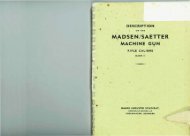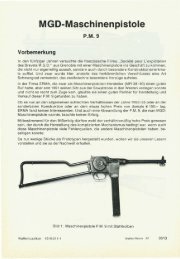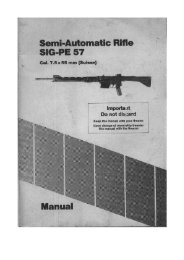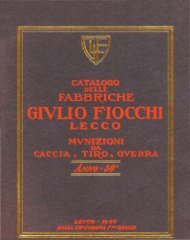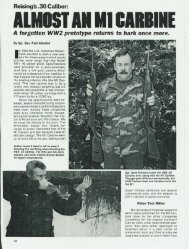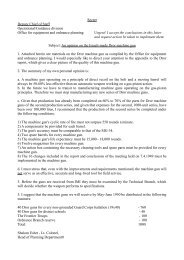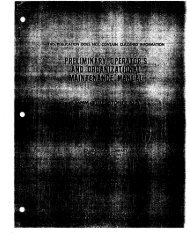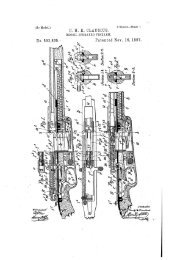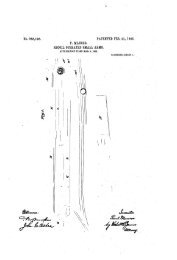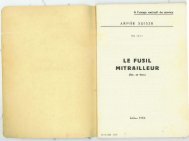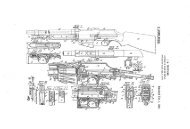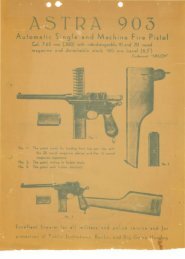The Parabellum Story (GunFacts).pdf - Forgotten Weapons
The Parabellum Story (GunFacts).pdf - Forgotten Weapons
The Parabellum Story (GunFacts).pdf - Forgotten Weapons
You also want an ePaper? Increase the reach of your titles
YUMPU automatically turns print PDFs into web optimized ePapers that Google loves.
ered in a V series, standing for<br />
"Versuchsmodell." Occasionally a Swiss<br />
Luger will turn up with a serial number<br />
apropos of nothing at all. Very<br />
recently, I examined a M1929 numbered<br />
100,000. Its authenticity is beyond<br />
any doubt whatever, and besides<br />
the serial number, which reflected probably<br />
nothing more than the Waffenfabrik's<br />
sense of humor, there was<br />
nothing unusual about the piece.<br />
W affenfabrik Bern managed to stockpile<br />
an enormous quantity of spare parts<br />
before the Luger was finally dropped,<br />
and for the past quarter century Switzerland<br />
has served as a <strong>Parabellum</strong><br />
parts depot for all of Europe. Fortunately<br />
the internal components of the<br />
Luger never changed much at all, even<br />
in the 1929 Model, and most parts,<br />
with the conspicuous exception of the<br />
vital sideplate, are roughly interchangeable.<br />
Evidently a goodly supply of<br />
sideplates was left over from the 06-24,<br />
for the latest Dynamit Nobel- Genschau<br />
(Germany's largest parts house) catalog<br />
lists it complete for $20; the receiver<br />
fork lists for $21.75, and only<br />
the frame is unavailable. Attesting to<br />
this German firm's source of parts<br />
is the fact that their catalog illustration<br />
is a poor reproduction of the<br />
parts list that Bern supplies to Swiss<br />
gunsmiths. DNG changed only the<br />
order numbers.<br />
When W affenfabrik Bern finally ran<br />
out of Lugers, the Swiss had been<br />
shooting the toggle gun for well over<br />
a half century, and had no intention<br />
of breaking the habit. <strong>The</strong> price of<br />
second-hand Lugers in Swiss gunshops<br />
has steadily spiraled, so that it's almost<br />
impossible to find one in good shooting<br />
condition for less than $125. So<br />
enamored of the <strong>Parabellum</strong> are the<br />
Swiss that many Swiss officers prefer<br />
to pay the difference for an 06-24<br />
rather than putting out the lesser<br />
tariff for the issue SIG. I saw 1968<br />
films of military qualification firing in<br />
one of the cantons, and the Luger<br />
still clearly outnumbered the Neuhausen<br />
pistol. <strong>The</strong>re' s no question as<br />
to which gun is the more effi cient.<br />
It's that old mystique again-in Swiss<br />
eyes the Luger is the ultimate handgun.<br />
Attesting to its widespread t.:sage,<br />
the latest Bern-issued gunsmith's manual<br />
for the <strong>Parabellum</strong> is dated 1965.<br />
A vigorous market existed in Germany<br />
as well, with nothing much to<br />
fill it. By 1960, Second War P-08's<br />
were bringing $100 in German gunshops,<br />
and the price for a good one is<br />
up to $150 at this writing. <strong>The</strong>se facts<br />
weren't lost on the Erma- Werke at<br />
Dachau, who had been marketing 22<br />
caliber and 4mm rimfire conversion<br />
units since about 1910, and who had<br />
heavily committed themselves to the<br />
toggle-breech priniciple with their post-<br />
40 GUNFACTS/ AUGUST-69<br />
Vast SIG complex at the Rheinfalls was the only plant in Switzerland to make the Luger<br />
frame.<br />
war line of cast zinc Luger look-alikes<br />
in 22 Long Rifle.<br />
About 1960, a substantial lot of diverse<br />
<strong>Parabellum</strong>s found their way out<br />
of Bulgaria into neutral Austria where<br />
they were quickly pounced upon by<br />
Interarms' purchasing agents. Those<br />
deemed too mangy for the U.S. market<br />
were sold to Erma for $15 each. <strong>The</strong><br />
exact quantity involved is still unclear.<br />
Erma's managing director insists that<br />
they got only 1,000 pistols from Interarms,<br />
and of these only 800 were salvageable.<br />
Interarms' representatives,<br />
on the other hand, recall selling between<br />
two and three thousand pistols<br />
to Erma, and note that since the transactions<br />
took place while Erma was<br />
changing hands, present management<br />
may be cognizant only of the later<br />
shipments.<br />
At any rate, Erma, taking a closer<br />
look at their merchandise, was aghast<br />
at the condition of the pistols. Every<br />
barrel, without exception, had to be<br />
replaced, and for this purpose the<br />
Dachau plant tooled up for Luger barrel<br />
production. Most of this shipment<br />
came out with 30 caliber tubes. New<br />
grips, sights, magazines, and take-down<br />
latches as well were manufactured by<br />
Erma in order to get the guns back<br />
together again. Since production of<br />
sideplates or frames was out of the<br />
question, some stock buildup by welding<br />
was reportedly done on these parts<br />
to achieve a proper fit.<br />
<strong>The</strong> Bulgarian r-eworks went on sale<br />
in 1965. U.S. Army Rod And Gun<br />
Clubs accounted for a large portion of<br />
the total, and to American servicemen<br />
they sold at about $40 each. On the<br />
German commercial market, they<br />
started off at $50, but Erma was forced<br />
to jack the price first to $57.50 and<br />
finally to $67.50 as the cost of refitting<br />
them rose far beyond original expectation.<br />
<strong>The</strong> guns were delivered to distributors<br />
in military style wooden cases.<br />
Since they were put up from parts,<br />
markings were an absolute hodgepodge.<br />
Erma themselves applied no<br />
marks whatsoever, but the guns are<br />
easily identifiable since they carry German<br />
postwar Nitro proofing and the<br />
Munich proofhouse stamp, with circa<br />
1965 dating.<br />
Erma continues to manufacture and<br />
supply all of the parts mentioned<br />
above, a large portion of which previously<br />
went to Dynamit Nobel-Genschau.<br />
All distribution of Erma-built<br />
parts is now being taken over by Wilhelm<br />
Hebsacker, the surplus arms dealer-sort<br />
of a miniature Interarms-in<br />
Schwabisch Hall.<br />
Hebsacker, himself a Ferlach-trained<br />
gunsmith, had sold some 500 of the<br />
Bulgarian reworks. Recognizing a market<br />
as it stared him in the face,<br />
Hebsacker sponsored one of three European<br />
efforts to put the Luger back<br />
into production from scratch. After<br />
fairly careful study, he concluded that<br />
a new Luger would cost at least $125<br />
to build, and couldn' t be sold for less<br />
than $300. How much of a production<br />
run he was counting on, we don' t<br />
know , but the estimates squelched the<br />
whole idea. Hebsacker's figures, however,<br />
take on considerable interest since<br />
they form an excellent base for comparison<br />
with other postwar Luger cost<br />
studies.<br />
Back in the Alps, the Swiss Gunsmiths'<br />
Association, acutely aware of a<br />
good thing going to waste, petitioned




